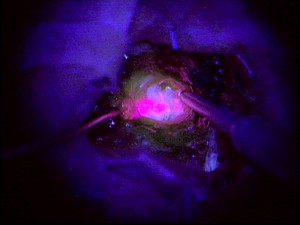New Imaging Agents may improve Glioblastoma Surgery
Cancer Research UK issued a press release today about a phase 2 trial (GALA-5) in glioblastoma that caught my attention.
The trial, led by Colin Watts from the University of Cambridge, will treat patients with 5-Amino-Levulinic Acid (5-ALA), a metabolic marker of malignant glioma cells. 5-ALA is preferentially taken up by brain tumor cells and then converted into a strongly fluorescing porphyrin.
This conversion by the body of 5-ALA to a fluorescent chemical, shows the location of the glioblastoma when imaged under ultraviolet light.
The practical application of this is that it allows better identification of the tumor margins and avoids the removal of unnecessary brain tissue.
The use of fluorescent imaging to aid surgery is also being investigated in other tumors. Sally Church on Pharma Strategy Blog recently wrote about the use of folate receptor alpha fluorescence imaging in ovarian cancer.
It will be interesting to see how the GALA-5 phase 2 clinical trial in glioblastoma progresses. The fluorescent imaging technology while promising is not without its pitfalls and potential risks.
As Jörg-Christian Tonn and Walter Stummer note in Vol 55 of “Clinical Neurosurgery” (2008) some of the pitfalls with fluorescence-guided resection using ALA include:
- Problem of overhanging margins i.e. inability to see all the tumor in the field of vision
- Cysts leading to collapse of parts of the tumor with the result that areas are missed
- Wrongly placed craniotomies preclude complete resection of contrast-enhancing tumor
- Some cases of gliosarcoma show only modest fluorescence accumulation
- Delay in drug administration may lead to less than optimal fluorescence
- Exponential decrease in light with growing distance to fluorescent tissue, resulting in weak fluorescence intensity
No doubt many of the above issues will be controlled for in the GALA-5 trial. The challenge with imaging techniques is, however, in consistency and reproducibility outside of experienced clinical research investigation sites.
It will be interesting to see whether the potential pitfalls can be overcome such that this promising experimental imaging becomes routine in glioblastoma surgery.
Story Source: BBC Health
